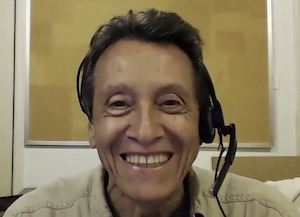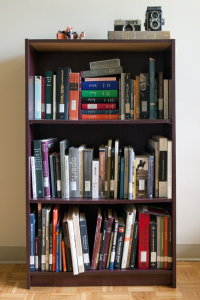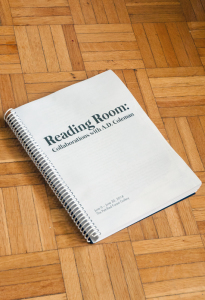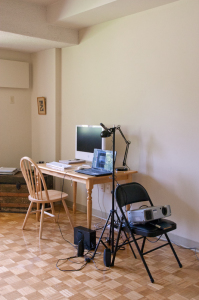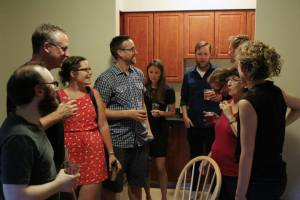Ruth Skinner and I hadn’t met, or made prior contact in any way, when she emailed me in April 2014 to initiate a conversation about centering a physical installation around my critical writings — not a permanent space but a pop-up environment that could occupy a temporary site anywhere. In the first draft of her description she suggested locally sourced secondhand furnishings (armchairs, reading lamps, table), a selection of my published books and some monographs in which my introductions appear, plus some print-outs of assorted essays as takeaways.
I found the concept provocative, appreciating the sense of contingency that the rotation of this environment from venue to venue would generate. But I thought we could take it further. I’ve published websites since 1995, involving my own work and content generated by others. Since 2003 I’ve used assorted vehicles for real-time online interaction: iChat, Skype, Google+ Hangouts. Via the latter two apps I’ve become comfortable with distance learning, making virtual visits to post-secondary classes and teaching online seminars.
So, in response to Ruth’s invitation, I proposed enhancing the visitors’ experience by making available to them real-time interaction with me (if desired), via Google+ Hangouts; making other relevant materials available online; and creating a website dedicated to the project, where visitors could track its progress and comment on their experiences. You can always find it at photoreadingroom.com
That’s where you are now, as you read this. Let us know what you think.
— A. D. Coleman
•
The idea for Reading Room was inspired by other reading-room and study-space exhibitions and conceived from the desire to create a project around the theme of practical criticism. I had a copy of A. D. Coleman’s Light Readings on my bookshelf as something to pick up and thumb through when I wanted a break from less readerly or overtly theoretical texts, and he struck me as a fitting potential patron for the space.
I wanted the reading room to be a comfortable and welcoming drop-in place where participants could choose to actively engage with the critical material collected there, whether through lectures, discussion groups, more informal and intimate conversations, or simply reading through material individually. As I often find myself using the interview or discussion format as an analytical and collaborative resource, I was very happy to organize dialogues with Coleman himself.
What resulted was a month-long event that emphasized the accessibility of “artspeak” and artistic action, and featured a full program of exchanges with Coleman augmented by discussion panels, workshops, and mini-exhibitions with London, Ontario-based artists.
Here’s how I described this ongoing project at my own website. And here’s the Facebook page I’ve set up for it. Follow us on Facebook for announcements of upcoming installations and online sessions. If you’re interested in hosting an installation of Reading Room in your venue — private/pop-up gallery, commercial or no-commercial gallery, art institute or university gallery, art or photo festival, museum, or other site — contact me for details.
— Ruth Skinner
